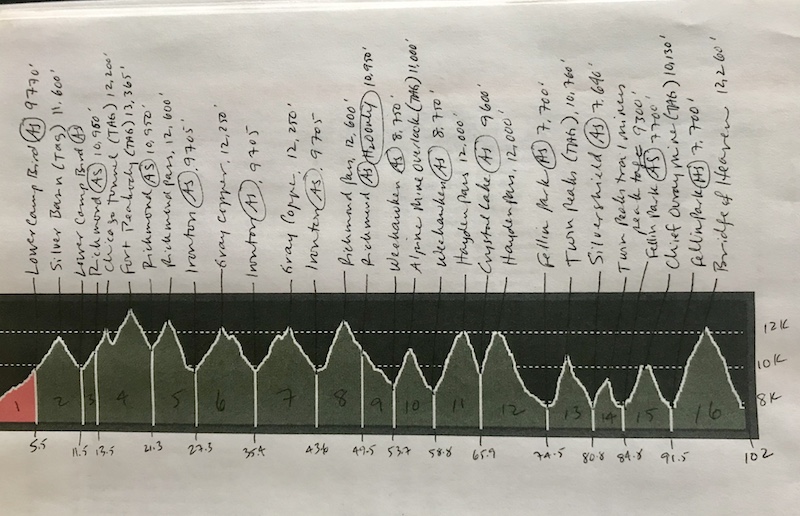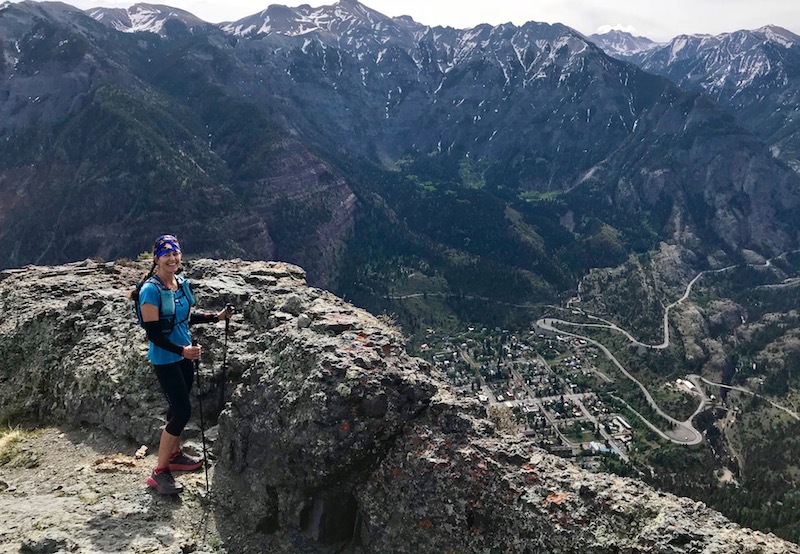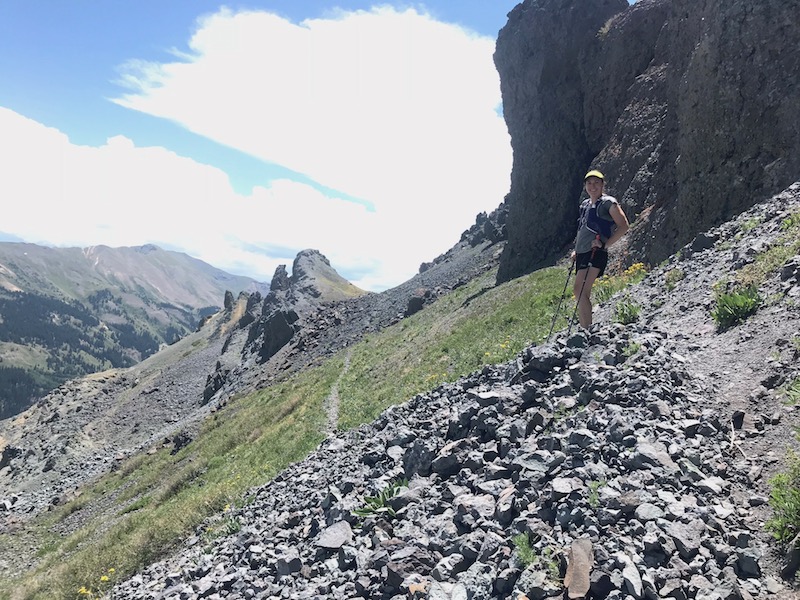Hardrock, Hardwalk, Wild & Tough, Kiss the Rock—I’m getting over last week’s Hardrock and letting go of longing for it. I’ve found another event to capture my heart or at least fill my headspace.*
As much as I’ve hoped over the past several years to run the Hardrock Hundred Endurance Run, and as much as I’ve savored flirting with Hardrock by getting involved as a pacer or volunteer in years past, I’m accepting the likelihood I’ll never get into that venerable, clubby 100-mile race that loops around the San Juan Mountains, due to its daunting lottery odds for the mere 45 spots available to first-timers.
(* I say that now. But I know, I will continue to yearn for a chance to be a Hardrocker, and I’ll keep entering its hopeless lottery with a feeling of futility each November. If someone named Dale calls my name, I’ll come running …)
This year, I decided to turn my sour grapes into fortified grape juice and attempt an upstart, scrappy race the following weekend, on the same mountain range, that’s arguably even more difficult (approx 41,000 feet of elevation gain up 14 major passes or peaks). It’s a race that almost any 100-mile ultrarunner can enter due to its more relaxed qualifying standards and, for now, its lack of a lottery (though I predict it’ll rocket to popularity in the coming years, in large part due to Hardrock’s impenetrability).
It’s the 5th running of the Ouray 100-mile Endurance Run!
This Friday morning, July 27, I’ll be one of 98 entrants starting the Ouray 100—22 of whom are female, almost 23%, a much better representation than at Hardrock, where only 13 of this year’s 146 runners, or 9%, were female.
Since this Ouray 100 is still relatively unknown, and it’s still working to repair a reputation tarnished by an inauspicious first couple of years, I decided to write a preview with some stats and background, as well as a snapshot of my training and present freak-out.
Some Facts & Orientation to the Ouray 100
Whereas the Hardrock 100 is a giant loop, the Ouray 100’s route looks like an alien insect with legs and stingers branching out from a spine, with a loop like a head at its southern end. The 100 miles feature a series of out-and-backs, plus one double loop, and runners must tag several peaks using a hole punch placed at the top of some of the peaks. (I’ve had anxiety dreams about searching in the dark on a mountaintop for a hidden hole-puncher.) We also must traverse two big passes that connect the “spine” of Camp Bird Road with Highway 550.
Here is a map that shows the overview, which I annotated to show the different sections that are reflected on the elevation profile below. The start/finish is at Fellin Park next to the Ouray Hot Springs (same place as Hardrock’s Ouray aid station).

And here’s the elevation profile, with the peaks and passes, and their elevations, labeled:

You can read the course descriptions here and follow along with live tracking on race day here.
If you want a great overview of the course, watch this documentary film, the Ouray 100, about Avery Collins running the 2016 Ouray 100, available through Amazon Prime.
One big difference between Hardrock and Ouray: Ouray will be more sociable insofar as runners pass each other several times on out-and-backs. As a rookie to this event, I like that. Also, it’s much easier for crew and pacers to reach their runners. The three main aid stations with crew access (Fellin, Crystal Lake, Ironton) are all along Hwy 550 within about 25 minutes of each other.

One of my first training runs this season on the Ouray course, back in early May (when the mountains still had a little snow) on the Twin Peaks part of the route (Section 13 on the elevation profile), overlooking Ouray.

My friend and coaching client Tara, who’s doing the 50-mile version of the event, on the Hayden Pass section of the course (sections 11 and 12 on the elevation profile) during one of our training runs a couple of weeks ago.
A Brief History of the Ouray 100
I was under the impression that the Ouray 100 cropped up as a market response to Hardrock’s popularity, a chance to capitalize on the difficulty of gaining entrance to Hardrock. But two weeks ago, when I sat down with race director Charles Johnston to chat about the Ouray 100’s origins, I discovered I was wrong. This event started out as a whim, independently and almost randomly. Here’s a timeline; there’s a bigger story to be written here, but I’m keeping it relatively short because I’m busy getting ready for the event and need to go to bed early (as if!), and I want to develop this story more and talk to others about it.
2013: Charles Johnston, then only 29, moved with his wife from Houston, Texas, to Montrose, Colorado, for a job. Charles has a background as runner who dabbled in ultras, influenced like so many by Dean Karnazes’s Ultramarathon Man, but he knew almost nothing about southwestern Colorado and was pretty clueless about the Hardrock 100. (He has since graduated to running the Moab 240.) He’s a CPA who started working as a CFO for a company near Montrose, and a passionate guitar player. But he didn’t have aspirations to become a race director until he took a foray up Imogene Pass Road and became dazzled by the San Juan Mountains around Ouray. He also paced 40 miles at the Leadville 100 that year and got a taste of Colorado ultrarunning through that experience.
“I was oblivious to this area—I didn’t know this part of the world existed,” he said as we sat in the Starbucks inside the Montrose City Market.
2014: Charles got the notion to become a race director, on top of working full time and becoming a dad. But he didn’t start gradually. This is a guy who goes all in and thinks big; he and his wife had four kids over the past five years, for example.
“I’ve been described as a high-functioning crazy person,” he told me, his furrowed, thick eyebrows, and intense gaze behind glasses, making his face look dead serious.
So he launched a small, low-profile 50K near Montrose in May of that year, a 100K near Gunnison in June, another 100M near Crawford in July, and the first-ever Ouray 100 in August, because, why not? Even though he was new to race directing, an outsider with few connections to recruit volunteers, he decided to go for it.
“I wanted to try it, to see if I could do it,” he said. “I lost a ton of money. It was a disaster.”
Still, he managed to pull off the first annual Ouray 100, with 35 starters and 19 finishers—but it was a completely different course than today’s route. Hence, the first year of the Ouray 100 doesn’t really count in comparison to the current event. It had “only” about 20,000 feet of elevation gain and followed a lot of county roads. Courtney Dauwalter, lesser known at the time, was first female and second overall in 26:46. But no one pays much attention to the 2014 edition of the Ouray 100 because Charles went on to change it completely.
He says runners asked him afterward, “Why didn’t you keep it more in the mountains?” So Charles consulted with longtime Ridgeway runner and retired RD Jan Peart about how to improve the course. He says she sketched out what’s close to the current route on a napkin. He liked how it was geographically concentrated, to simplify permitting and aid stations.
He made a new route proposal, added up the elevation gain, and discovered it came to around 38,000 feet. (The Hardrock 100, by comparison, climbs 33,000 feet.) “I thought, I can’t just do 38. It’s gotta go over 40,000,” Charles recalls. So he modified the route some more, got the permit approved, and got ready for the 2015 edition.
How did 2015 go? Oh, the horror, the horror.
2015
Charles realizes now in hindsight that he could have done a lot more to prepare runners’ expectations for the radical course change and skyrocketing difficulty from the 2014 to 2015 editions. “I did a terrible job emphasizing that it was going to be a bloodbath with almost 42,000 feet of climbing,” he said.
Charles set an ungodly 4 a.m. start time. (He has since changed it to a very civilized 8 a.m. start.) Then he got to race-day morning sleep deprived and stretched way too thin due to a combination of factors—his company was going under, prompting a wave of layoffs he had to announce; he had newborns and toddlers at home; he was tired from helping with the Colorado 200 a couple of weeks prior—and all that conspired to make him reach his own event exhausted and tardy. He showed up 15 minutes late to the start of his own race, facing a mob of angry runners. “I was running on fumes at that point, and I didn’t have the bandwidth it [the Ouray 100] deserved,” he said in his candid, straightforward way.
Then the event went from bad to worse when the tracking function he had promised runners and crew didn’t work out, so crew had no way to track their runners. Plus, for 48+ hours, the sky dumped rain as only the San Juan Mountains can. “The weather was awful, like something from a movie,” he said.
Because of the topography and stormy sky, GPS watches went nuts and inaccurately tracked significantly longer mileage than the course actually measured, creating more confusion and anger among runners.
Forty-five runners started. Nine finished.
“I don’t think it was a good experience for anyone,” Charles sums up the 2015 Ouray 100. “I overpromised and underdelivered.”
A handful of pissed-off participants provided a kicker to the 2015 edition: They lobbied the Forest Service to revoke the event’s permit. (This is all according to Charles; I haven’t talked to others about this yet, but hope to find out more of the full story after this year’s event.)
Charles could have given in or given up, but instead, “I came back with full fury, ready to fight.” He felt determined to correct his event’s shortcomings and make the event a respected, sought-after 100-miler.
2016 and 2017
I didn’t have time to talk to Charles about what happened over the past two years—our time ran short in our interview—but you can see the story yourself by watching the Ouray 100 documentary linked above (filmed in 2016, with some additional footage from 2017).
In 2016, only 30 runners started the 100-miler, and only 5 finished. Avery Collins won in 34:01, and the fifth official finisher took 50:25. No woman finished the event since the new course was introduced in 2015.
In 2017, participation jumped up to 58 starters, with 22 finishers. Chris Price won in 30:46. Most notably, the first woman, Melissa Beaury of Moab, finished in a fast time of 34:26, and three other women also finished.
Who knows how 2018’s race will unfold? I’m grateful to RD Charles Johnston for having the vision and tenacity to develop and improve this event, which seems this year to have finally reached a critical mass for participation.
A Brief Lament About My Training and Expectations
It’s getting late on Wednesday night, and I should be getting to sleep rather than doing this blog post. Suffice to say my training is not what I hoped it would be, but I believe it’s good enough. My only truly long, all-day training run was the San Juan Solstice 50-miler in June (a little under 14.5 hours). I only had one week, the week of July 2, that amounted to more than 70 miles of training. I hope to be like one of those old-goat veteran Hardrockers who don’t train at a very high volume but who leverage muscle memory and wisdom from past ultras to tough it out.
On a more positive note, I’ve been adapting to these high-altitude mountains since early May, and I’m on my feet and much more active than when I’m living in the Bay Area. I was able to get to Ouray and scout out many segments of the route. And I feel logistically organized with a great team supporting me! From mile 53 to 74, my friend Allison Snyder of Ophir, who co-guides the San Juan Mountains Running Camp with me, is pacing me; then, the ultra-experienced Lisa Henson takes over pacing me for the last quarter of the event while her husband Tropical John Medinger helps as crew. Meanwhile, my wonderful ultrarunning friend and pacer Clare Abram will be my crew chief the first 74 miles. Then she puts on her pacer hat and paces my friend and client Tara Butson, who’s doing the 50-mile version of the event, for the final 25 miles of her race. Not pictured below: My phenomenal husband Morgan, who also will be in Ouray crewing and managing our kids and animals.

(L-R) my awesome team: Clare Abram, Allison Snyder, me, John Medinger, Tara Butson, Lisa Henson, and Zephyr the wonder dog at the crew/pacer lunch meeting at my place today.
I’m feeling overwhelmed but excited about Friday through Sunday. My best-case scenario estimates me finishing around 42 hours. But the event has a 52-hour cutoff. That means I could finish anytime between 2 a.m. and 12 p.m. on Sunday. I can’t fathom running and hiking into a second night. I’m also wickedly frightened of the thunderous storms hitting hard each afternoon; just today, we had a hail and rain deluge with ear-splitting thunder and lightning. I really don’t want to be above tree line on an exposed mountain pass when a storm like that hits Friday or Saturday—but I could be. I’ll just have to live and breathe the Hardrock “wild & tough” motto and get through it, one mountain pass at a time.
Gear Essentials
Given the afternoon downpours happening almost daily here, I need to be well prepared with many layers of dry clothing available in my pack and drop bags. These are the key pieces of gear I’m using and recommend:
UD’s Women’s Ultra Jacket V2 (available in men’s style too)
UD’s Women’s Ultra Pant V2 (ultralight & comfy rain pants, also available in men’s style)
UD’s Adventure Vesta 4.0 (favorite large-capacity hydration vest with trekking pole holders and lots of great features)
Black Diamond Z-Poles(essential for helping me get up and down the loose scree and to gain stability on sketchy segments with drop-offs)
And to carry it all: UD’s Crew Bag, an ingenious duffel with lots of see-through outer pockets and inner pockets for organizing, and backpack straps for carrying
For fuel I’m relying on GU products—Rocktane drink mix, Rocktane gels and Stroopwafels—because they’re highly effective sources for calories and electrolytes, and they’re easy to get down while breathing hard in the thin, dry air on the trail. I’ll eat more substantial food at aid stations.

One Last Request & Reminder
Tapering has given me fresh legs. But my book needs fresh legs, too! You can really help by recommending my book on Amazon with a customer review, or by giving it a social media shoutout. What, you say you haven’t read The Trail Runner’s Companion? Please check it out! The Trail Runner’s Companion: A Step-by-Step Guide to Trail Running and Racing, from 5Ks to Ultras
Allison and I are seeking more signups for our Sept. 23 – 26 camp in the mountains above Ouray and Ophir. If you’d like to run around these mountains when the aspens are turning golden, please join us! Check out my last blog post to learn more about it, and see this website.
Now it’s time to sleep, pack, head to Ouray and go offline until the end of the event on Sunday, July 29!

That race looks incredible. Curious to hear your thoughts after your finish. One question: any idea why it isn’t an HR qualifier (I’m 4 years into what I’m guessing is the 12 year HR lottery plan).
The Ouray 100 website states: “We applied to become a Hardrock qualifier in 2016. We were not selected. The HR Board indicated they did not need any new qualifiers. When/if new qualifiers are added, Ouray may be considered.”
Good Luck….wishing all goes well…